Recent regulatory changes by the US and Germany in late October are expected to result in an increase in civil aviation flights by operators from each country in Iraqi airspace (FIR Baghdad (ORBB)). However, these regulatory changes have occurred in the wake of the 10 October Iraqi national elections in which the Fatah Coalition, which represents the interests of multiple Iranian-backed militant groups (IBMGs) in Iraq, lost a majority of its seats in parliament as a result of a poor electoral showing. In the weeks since the elections, tensions have been rising in Iraq. Several IBMGs have raised the alert levels of their forces within Iraq, and other associated groups, as well as the Fatah Coalition, are vowing to challenge the legitimacy of the elections. Prior to the elections, Osprey published a case study on IBMG weaponised drone use in FIR Baghdad (ORBB) and the evolving threat to aviation operations within Iraq.
During 2021, IBMGs have shown an enduring capability and intent to conduct indirect fire and drone attacks against airports and airbases in Iraq where US military forces are present. The US military and Iraqi Armed Forces have air and air-defences capable at all altitudes deployed within several areas of the country. While the US military and Iraqi Armed Forces have been successful in thwarting some IBMG indirect fire and drone attacks as well as deconflicting air and air-defence operations with civilian flights, such activity poses an inadvertent risk to all forms of aviation activity at all altitudes within FIR Baghdad (ORBB). Of additional concern, IBMGs have a documented capability to target air assets over Iraq at altitudes up to FL320 and have displayed a persistent intent to engage military-grade aviation targets inflight within FIR Baghdad (ORBB).
Regulatory Developments
On 22 October, the US FAA rescinded its NOTAM for Iraqi airspace, which had prohibited US civil aviation operations in FIR Baghdad (ORBB) at all altitudes (KICZ A0036/20). However, US Special Federal Aviation Regulation (SFAR) 77 remains in effect for Iraqi airspace and continues to prohibit US civil aviation operations in FIR Baghdad (ORBB) at altitudes below FL320.
On 21 October, Germany issued a NOTAM (EDGG B1405/21) for FIR Baghdad (ORBB), which is valid until 2 December and includes the same advice that was provided within the current AIC 14/21, which advises against conducting flights below FL260. However, the NOTAM includes a new exception – As-Sulaimaniyya (Sulaymaniyah) province, east of airway UM688, including Sulaymaniyah International Airport (ORSU/ISU).
Several aviation authorities have issued advisories in the past year regarding Iraq.
IBMG Air-Defence Activity
The US FAA has stated in previous reporting that “Iran has a history of proliferating advanced weapons capabilities to its proxy groups” and could provide IBMGs in Iraq and/or eastern Syria with “additional and more advanced anti-aircraft capabilities”. On 21 October, an Iranian-backed militant group (IBMG) Popular Mobilisation Unit militia in Iraq displayed an Iranian-made ‘358’ surface-to-air missile (SAM) in Tuz Khurmatu of Iraq’s Salah ad-Din Governorate. This marks the first appearance of the ‘358’ SAM in the possession of a violent non-state actor (VNSA) group in Iraq, though IBMGs in Syria reportedly took possession of limited stocks of these systems earlier in 2021.
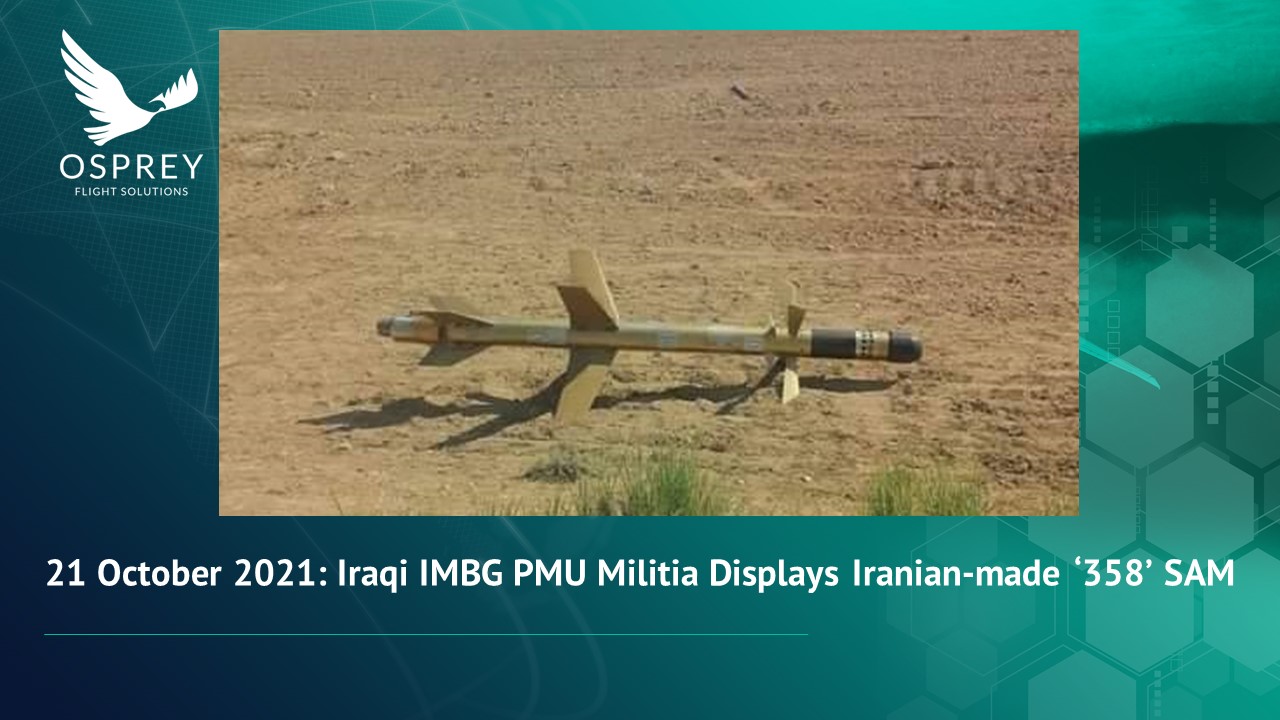
The Iranian-backed Yemeni Houthi rebels have been in possession of ‘358’ SAM systems since 2019. Houthi-bound weapons shipments from Iran’s Islamic Revolutionary Guard Corps (IRGC) interdicted by the US military in February 2020 and November 2019 reportedly included ‘358’ SAM system components. Houthi rebels reportedly launched ‘358’ SAMs against US drones over Yemeni airspace on several occasions in late 2019 and into 2020; however, the engagements have allegedly been unsuccessful to date.
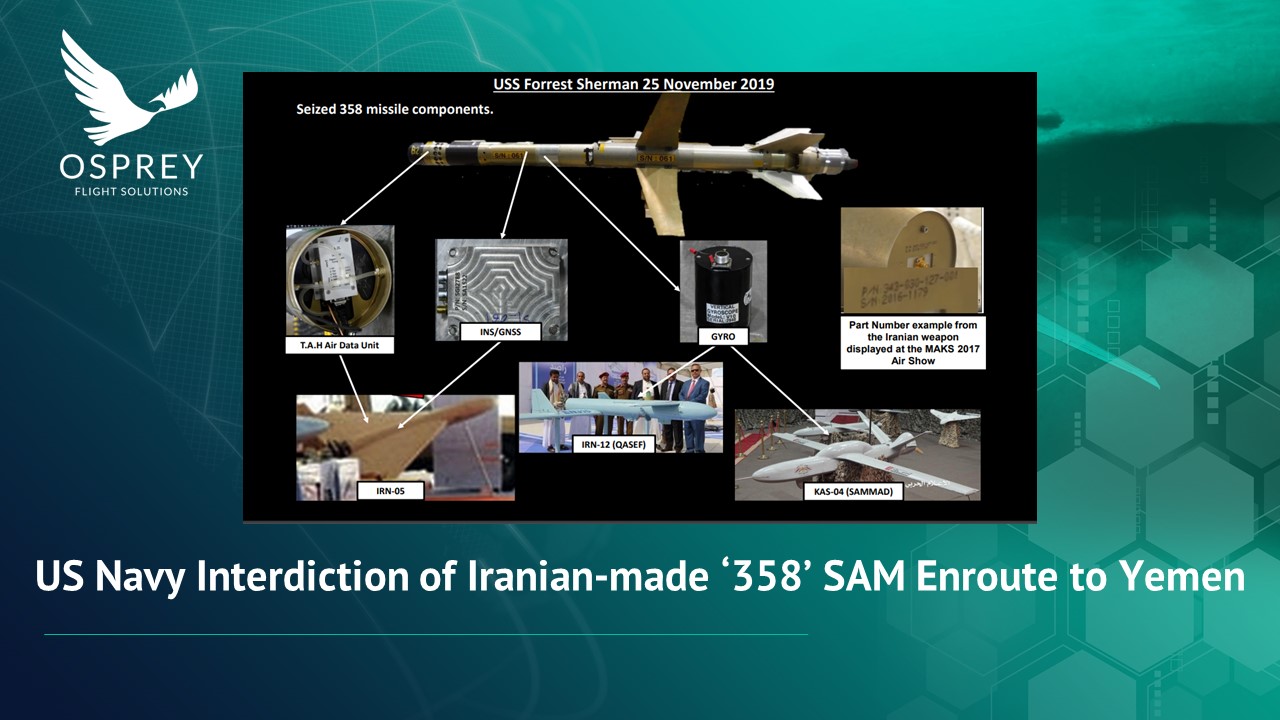
Analyst Comment
We assess the ‘358’ SAM system to be both distinctly different functionally as well as more capable than man-portable air-defence systems (MANPADS) in IBMG possession in Iraq. We assess the ‘358’ system is an electro-optically guided, loitering-capable SAM due to the missile body and rocket mortar design features observable in the images that have been publicly released. Lock-on before launch is not required for this SAM as, once the missile is fired and travelling at an adequate speed, a solid-fuel boost rocket motor drops from the munition and a cruise motor takes over. At that point, the weapon flies in a figure-of-eight pattern, likely above FL200, and looks for targets to engage while loitering. We also assess the ‘358’ SAM is capable at altitudes up to at least FL320 – if not much higher – as well as at ranges beyond 20km (12.4 miles), and the full capabilities of the system have not been publicly released by Iran, or Western governments for that matter. The ‘358’ system is assessed to be the most capable SAM system in the possession of IBMGs in Iraq, and it poses the highest priority threat from VNSAs to air assets inflight over Iraqi airspace, including at altitudes above FL260 and up to at least FL320.
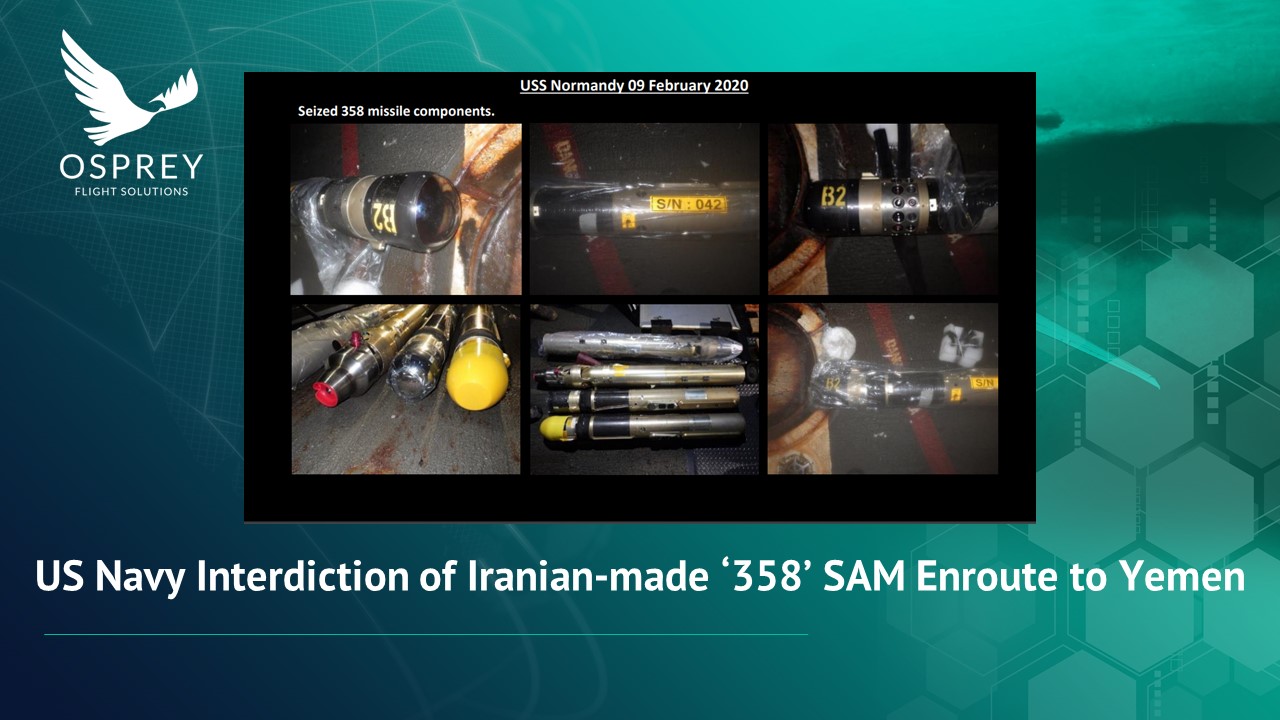
IBMGs have possessed MANPADS capable below FL260 since at least 2004, including Chinese-made QW-1 and/or Iranian-made Misagh-1/2 variants along with Russian-made Strela and Igla series. Of most concern, an IBMG is alleged to have unsuccessfully targeted a civilian airliner inflight over Iraq via MANPADS employment in 2004, according to US government reporting. Below is an outline of activity demonstrating IBMG air-defence capability and intent beyond the MANPADS and ‘358’ SAM discussions above:
- Since August 2019, IBMGs have claimed engagements targeting military-grade air assets below FL260 in flight over Iraq on over a dozen occasions;
- Reported deliveries of MANPADS to IBMGs in Iraq from the Iranian IRGC occurred as recently as October 2019;
- During April, June and September 2020, IBMGs threatened to target US military air assets over Iraq via MANPADS employment;
- On 17 April 2020, an IBMG published a video of an unsuccessful targeting of a US military helicopter via Russian-made 9K32 Strela-2 (SA-7 GRAIL) MANPADS engagement south of Baghdad;
- The “Kataib Sayyid al-Shuhada” IBMG – which was targeted on 27 June by US airstrikes on the Iraqi-Syrian border – stated in response to the raids: “from now on we will enter into an open war with the American occupation and target its aircraft in Iraq”.
- On 28 June, the “Seraya Oulia Al-Dam” IBMG threatened to attack US military aircraft in Iraqi airspace – specifically mentioning near Erbil – via unspecified means in retaliation for the airstrikes on the Iraq-Syria border.
- On 29 July, an IBMG allegedly downed an Iraqi military helicopter via SA-7 MANPADS engagement over Amerli District, Salah ad-Din Province.
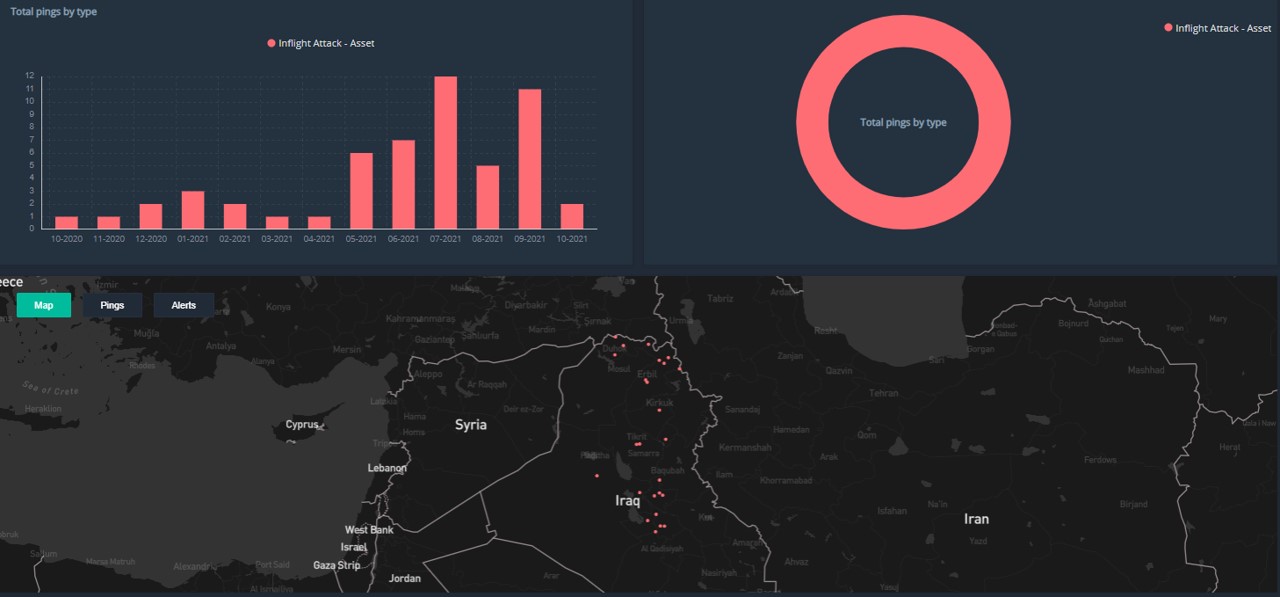
Analyst Comment
Osprey assesses there is an elevated likelihood of limited sets of US military strikes against IBMG targets in Iraq and/or the Syrian border area through the remainder of 2021. Aerial operations by the US against IBMGs in Iraq and/or eastern Syria in the final months of 2021 – should they occur – would increase the likelihood of attempted surface-to-air fire engagements targeting military-grade air assets above and below FL260 in the wake of the emergence of the ‘358’ SAM system. Separately, IBMG armed attacks against fortified installations with aviation infrastructure in Iraq and eastern Syria may occur as a means of retaliation against foreign interests.
IBMG Drone, Missile & Rocket Activity
While IBMGs conducted over 80 rocket attacks against installations where US forces were present since 2018 – including against airports and air bases – the use of weaponised drones and military-grade air-defence system employment in response has become the dominant threat to air operations over Iraqi and eastern Syria airspace during 2021. IBMG possession of military-grade drones has been documented since 2014. Credible reporting indicates transfers of such weapons by Iran to specific groups occurred recently, and IBMGs displayed their drone fleet during parades in Iraq’s Diyala Province in June. Previously, on 27 June, the US military conducted a limited set of airstrikes on the Iraq-Syria border targeting weapons storage facilities belonging to IBMGs. A US Department of Defense statement indicated that the targets hit were used by IBMGs engaged in drone attacks against US interests in Iraq.
Since the start of the year, suspected IBMGs in Iraq have conducted over 15 drone attacks, which have targeted the Baghdad Green Zone, Baghdad Airport (ORBI/BGW), Baghdad Al Rasheed Air Base, Erbil Airport (ORER/EBL), Balad Air Base (ORBD/XQC) and Ain Al Asad Air Base (ORAA/IQA). In addition, drone attacks in 2021 by suspected IBMGs in Syria have targeted US military bases in Al Tanf as well as the Al Omar and Conoco oil fields in eastern Dayr az Zawr Governorate along the Iraqi border. IBMGs reportedly launched drones from southern Iraq targeting sites near the Saudi Arabian capital, Riyadh, on 23 & 26 January this year, 14 September 2019 and 14 May 2019. On 18 May, the Israeli Air Force reportedly shot down an Iranian-made military-grade drone that had been launched from either Syria or Iraq.
Rocket attacks by IBMGs against installations where US forces were present in Iraq and eastern Syria have occurred on multiple occasions in 2021. Targets of these indirect fire attacks include the Baghdad Green Zone, Baghdad Airport, Erbil Airport, Balad Air Base, Ain Al Asad Air Base as well as the US military bases in the Al Omar and Conoco oil fields. Of note, an IBMG conducted a casualty-causing rocket attack on Erbil Airport on 15 February. The US military conducted airstrikes on 25 February against IBMG targets on the Iraq-Syria border.
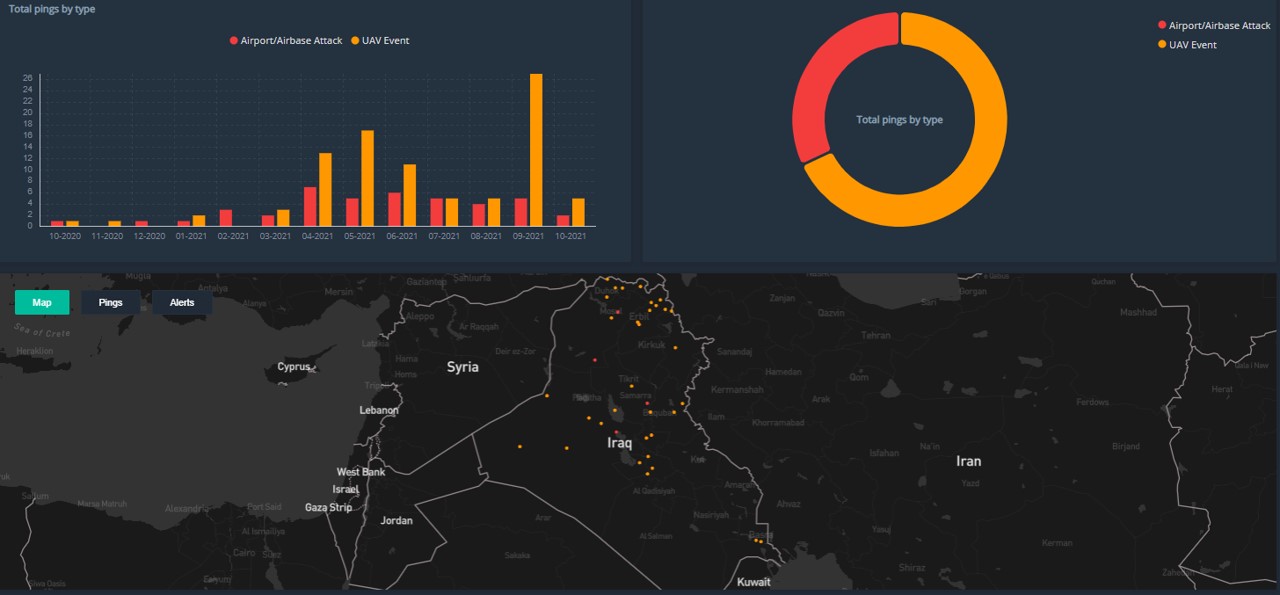
Credible reporting from as recently as December 2020, along with reports dating back to 2018-2019, indicate that the Iranian IRGC has delivered short-range ballistic missiles (SRBMs) as well as cruise missiles to several IBMG militias based in Iraq and on the Syrian border. While IBMGs have yet to employ SRBMs or cruise missiles in attacks, several suspected Israeli military airstrikes reportedly targeted advanced conventional weapons stores provided to such groups by the Iranian IRGC on several occasions since 2019 in Iraq and on the Syrian border. IBMGs in Iraq and the Syrian border are more likely to employ drones and/or unguided rockets in attacks, though strikes involving SRBMs and/or cruise missiles cannot be ruled out completely.
Analyst Comment
The above indicates that IBMGs in Iraq and Syria continue to maintain a steadfast capability and intent to attack aviation targets, and drone strikes remain a credible enduring scenario going forward. Indirect fire and drone attacks against airports and airbases in FIR Baghdad (ORBB) pose a direct threat to civil aviation, both in federal Iraq as well as in the northern Kurdistan Region. Aircraft on the ground at installations in Iraq and eastern Syria – both military and civilian – face a credible risk of being damaged due to such attacks.
Iranian IRGC Drone, Missile & Rocket Activity
The Iranian IRGC has a documented history of conducting SRBM, cruise missile, guided rocket artillery and drone operations that have led to activity assessed to be hazardous to aviation at all altitudes in Iraq. During September, the Iranian IRGC launched multiple weaponised drone and guided rocket artillery strikes from the Urmia area of northwest Iran into the Qandil area of northeast Erbil province in the Iraqi Kurdistan region. The strikes reportedly targeted locations of the Kurdish Democratic Party of Iran (KDP-I) militia group, which operates in areas of northeast Iraqi and northwest Iranian territory. The Iranian IRGC conducted similar drone and guided rocket artillery strikes against the KDP-I in the Iraqi Kurdistan Region in 2020 during June and August of that year. In addition, in September 2018, the Iranian IRGC conducted SRBM, guided rocket artillery and drone strikes against the KPD-I in the Iraqi Kurdistan Region.
On a more concerning note, the Iranian IRGC launched 16 SRBMs targeting US military sites in Iraq at Ain al-Asad Air Base and Erbil Airport on 7 January 2020. On 14 September 2019, large-scale attacks targeted two major oil facilities in Eastern Province of Saudi Arabia involving 18 drones and seven cruise missiles. Despite the Houthi claim of responsibility for these strikes, they did not emanate from Yemen; the missiles and drones were launched by Iran and likely included overflight of southern FIR Baghdad (ORBB). In addition, on three occasions in 2017 and 2018, Iran reportedly conducted SRBM strikes from bases in west/northwest Iran Syria via Iraqi airspace, targeting the extremist Islamic State VNSA group.
Analyst Comment
Limited sets of drone and/or guided-rocket artillery strikes by the Iranian IRGC against the KDP-I in Iraq’s Kurdistan Region remain possible through the remainder of 2021. SRBM launches by the Iranian IRGC SRBM launches targeting the KDP-I, while less likely than drone or guided rocket artillery strikes, remain possible should operations against the Kurdish VNSA groups intensify. Though not expected to be likely at this time, if Iran were to conduct high-impact attacks via SRBMs, cruise missiles, guided rocket artillery and/or drones, then military facilities, airbases and airports across Iraq or eastern Syria where US military advisers are present are assessed to be primary targets. However, such an attack by the Iranian IRGC against US military forces remains significantly less likely in the near term than any kinetic actions by IBMGs in Iraq and/or eastern Syria.
US Military & Iraqi Armed Forces Air & Air-Defence Activity
During 2020, the US military deployed US-made MIM-104 Patriot conventional surface-to-air missile (SAM), counter-rocket, artillery & mortar (C-RAM) and electronic warfare (EW) systems at Erbil Airport and Ain Al Asad Air Base. C-RAM and EW systems are reportedly deployed at Baghdad Airport and in the Baghdad Green Zone. The US military reportedly has air defences and EW systems deployed at its main operating locations in eastern Syria, including at the Al Tanf Base as well as the Al Omar & Conoco oil fields. The Patriot is capable up to FL800 and out to 160km (100 miles). C-RAM systems are capable out to 3.5km (2.2 miles) and up to FL150.
While media reporting from mid June indicates the US military plans to withdraw Patriot systems from Iraq, these air defences remained present through September, and their removal has not been confirmed to date. US military Patriot deployments are assessed to be an effort to counter such attacks by IBMGs, as well as any similar strikes launched by Iran itself involving ballistic missiles, cruise missiles and/or drones. US military fighter jets capable at altitudes above FL260 may also be employed to shoot down drones over Iraq and/or Syria. US military forces in Iraq and Syria are also reportedly equipped with US-made FIM-92 Stinger man-portable air-defence systems (MANPADS) capable up to FL260.
Iraqi military forces have procured a variety of Russian-made MANPADS variants capable below FL260, including the 9K338 Igla-S (SA-24 GRINCH). The Iraqi Armed Forces also possess US-made AN/TWQ-1 Avenger Air Defence Systems capable up to FL260 and out to 8km (5 miles). Iraq has procured 24 Russian-made Pantsir-S1 (SA-22 GREYHOUND) conventional SAM systems capable up to FL490 and out to 20km (12.4 miles). The Iraqi Air Force is in possession of combat aircraft capable of conducting engagements at altitudes well above FL260. Such air and air defence weapons may be employed by the Iraqi military to shoot down drones over FIR Baghdad (ORBB).
Analyst Comment
The likelihood of additional near-term indirect fire and drone attacks targeting bases in Iraq and eastern Syria where US personnel are present remains elevated. As continued drone launches by IBMGs are anticipated to occur intermittently through the remainder of 2021, shoot-downs via conventional SAM engagement, air-defence weapons use, EW system operations as well as fighter jet air-to-air weapon employment are likely to be conducted by the US military and possibly Iraqi Armed Forces in response. Such air & air-defence operations may occur at all altitudes and pose an inadvertent risk to civilian aviation activity at any flight level, to include typical cruising heights above FL330.
Outlook
Strategic dialogue between Iraq and the US remains ongoing, with talks focused on a timeline outlining the presence of US-led coalition forces in the country. On 15 January, the US announced it had drawn down its military forces in Iraq to c.2,500 personnel, and all combat operations are set to finish by the end of 2021. Osprey assesses the rising tensions in Iraq in the wake of the national elections held on 10 October are likely to escalate further in the final quarter of 2021. The threats made by Kataib Sayyid al-Shuhada and Seraya Oulia Al-Dam noted above are assessed to be part of a broader effort by IBMGs to pressure the Iraqi government to end the US military presence in Iraq and Syria.
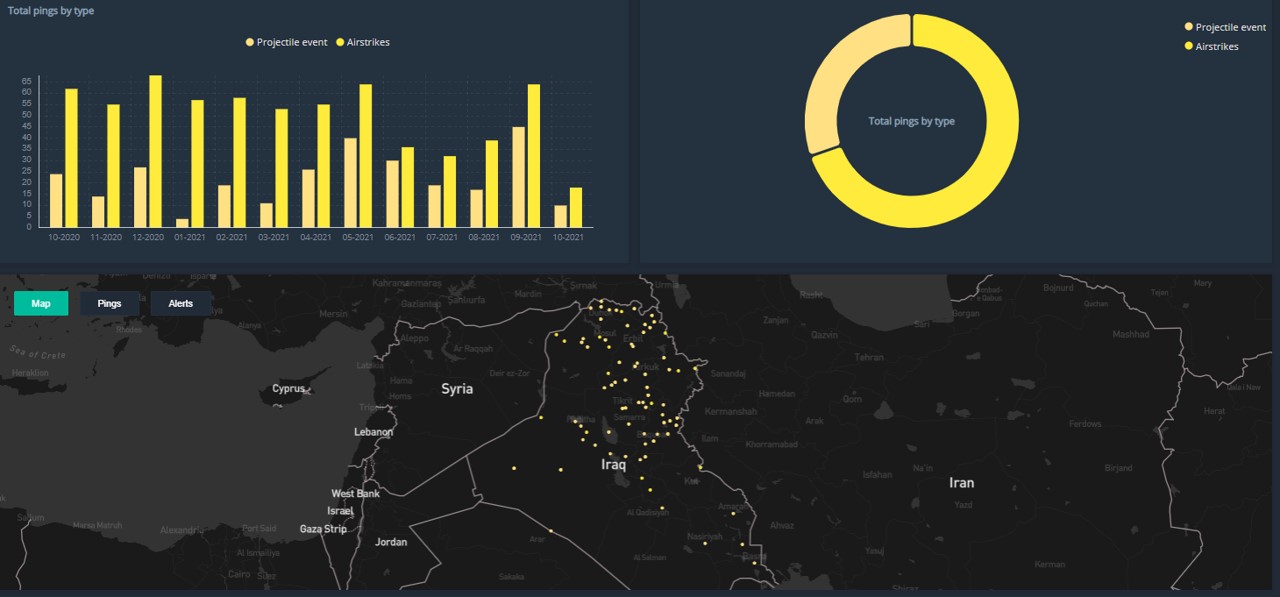
Should the US military fail to end combat operations by the end of 2021, further escalation of kinetic attacks by IBMGs in Iraq and eastern Syria would be a distinct possibility into 2022. The threat of IBMG asymmetric targeting of armed forces’ aviation installations, airbases and airports along with military and civilian aircraft above and below FL260 in Iraq and eastern Syria as a whole remains credible in the medium term. Airports, airbases and air assets above and below FL260 over Iraq and eastern Syria will remain vulnerable due to the high-impact nature of attacks against aviation targets by IBMGs.
The Iraqi Armed Forces and US military have an aggressive air intercept and shoot-down policy that allows air and air-defence forces to intercept and disable aerial targets violating FIR Baghdad (ORBB) airspace regulations. Military air and air-defence assets may be employed to down aerial targets at all altitudes under the auspices of the policy. While legal civil aviation flights are unlikely to be directly targeted, there remains a latent but credible risk of misidentification and interception by military air and air-defence assets at all altitudes.
Unannounced SRBM, cruise missile, guided rocket artillery and drone launches that transit airspace used by civilian aircraft pose a nascent inadvertent risk to operations at all altitudes. Iraq has a history of not issuing adequate notice of activities in its airspace that could affect flight safety. Multiple safety-of-flight concerns emanate from a situation in which an SRBM, cruise missile, guided rocket artillery projectile or drone malfunctions during the boost, mid-course, or terminal phases of flight. Such an event would cause the missile, projectile or drone to fly an unplanned trajectory and altitude profile, which could expose overflying aircraft to mid-air collision, route diversion and/or debris splashdown issues. Osprey recommends deferring flights over the entirety of FIR Baghdad (ORBB) subject to an operation-specific risk assessment. Should flights be undertaken, at a minimum, Osprey recommends the following risk mitigation measures in the airspace:
- Systemic risk assessment of each flight with automated threat intelligence integration;
- Flights over FIR Baghdad (ORBB) should occur during daylight hours only;
- Flights at Iraqi airports should be during daylight hours only & on short turnaround schedules;
- Security and operational risk-based identification of pre-planned divert airports;
- Defer diverting from flight plan except for ATC instruction or life-threatening situations;
- Reliable and redundant communications with an established communications plan;
- Fully coordinated and robust emergency response plan supplemented by asset tracking.








